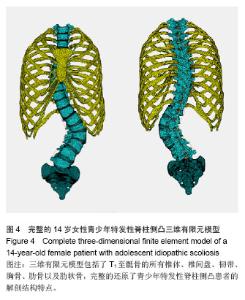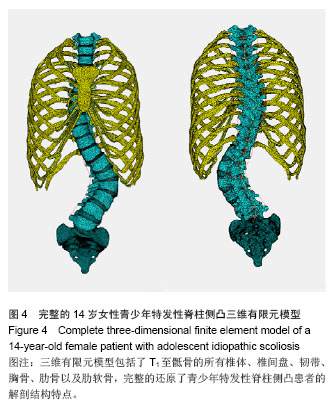| [1]Lonstein JE.Scoliosis: surgical versus nonsurgical treatment.Clin Orthop Relat Res. 2006;443:248-259.
[2]Belytschko T, Kulak RF, Schultz AB, et al.Finite element stress analysis of an intervertebral disc. J Biomech. 1974; 7(3):277-285.
[3]Qiu G, Zhang J, Wang Y, et al.A new operative classification of idiopathic scoliosis: a peking union medical college method. Spine (Phila Pa 1976). 2005;30(12):1419-1426.
[4]Goel VK, Monroe BT, Gilbertson LG, et al.Interlaminar shear stresses and laminae separation in a disc. Finite element analysis of the L3-L4 motion segment subjected to axial compressive loads. Spine (Phila Pa 1976). 1995;20(6):689-698.
[5]Kim HJ, Chun HJ, Kang KT, et al.A validated finite element analysis of nerve root stress in degenerative lumbar scoliosis. Med Biol Eng Comput. 2009;47(6):599-605.
[6]Nie WZ, Ye M, Liu ZD, et al.The patient-specific brace design and biomechanical analysis of adolescent idiopathic scoliosis. J Biomech Eng. 2009;131(4):041007.
[7]Chen CS, Cheng CK, Liu CL, et al.Stress analysis of the disc adjacent to interbody fusion in lumbar spine. Med Eng Phys. 2001;23(7):483-491.
[8]Braun JT, Ogilvie JW, Akyuz E, et al.Creation of an experimental idiopathic-type scoliosis in an immature goat model using a flexible posterior asymmetric tether. Spine (Phila Pa 1976). 2006;31(13):1410-1414.
[9]Van Rietbergen B, Odgaard A, Kabel J, et al.Direct mechanics assessment of elastic symmetries and properties of trabecular bone architecture. J Biomech. 1996;29(12):1653-1657.
[10]Viviani GR, Ghista DN, Lozada PJ, et al.Biomechanical analysis and simulation of scoliosis surgical correction.Clin Orthop Relat Res. 1986;(208):40-47.
[11]Stokes IA, Gardner-Morse M.Three-dimensional simulation of Harrington distraction instrumentation for surgical correction of scoliosis.Spine (Phila Pa 1976). 1993;18(16):2457-2464.
[12]Gardner-Morse M, Stokes IA.Three-dimensional simulations of the scoliosis derotation maneuver with Cotrel-Dubousset instrumentation.J Biomech. 1994;27(2):177-181.
[13]Azegami H, Murachi S, Kitoh J, et al.Etiology of idiopathic scoliosis. Computational study. Clin Orthop Relat Res. 1998; (357):229-236.
[14]Gignac D, Aubin CE, Dansereau J, et al.Optimization method for 3D bracing correction of scoliosis using a finite element model. Eur Spine J. 2000;9(3):185-190.
[15]Goto M, Kawakami N, Azegami H, et al.Buckling and bone modeling as factors in the development of idiopathic scoliosis. Spine (Phila Pa 1976). 2003;28(4):364-370; discussion 371.
[16]Perie D, Aubin CE, Petit Y, et al.Personalized biomechanical simulations of orthotic treatment in idiopathic scoliosis.Clin Biomech (Bristol, Avon). 2004;19(2):190-195.
[17]Liao YC, Feng CK, Tsai MW, et al.Shape modification of the Boston brace using a finite-element method with topology optimization. Spine (Phila Pa 1976). 2007;32(26):3014-3019.
[18]Lafon Y, Steib JP,Skalli W.Intraoperative three dimensional correction during in situ contouring surgery by using a numerical model. Spine (Phila Pa 1976). 2010;35(4):453-459.
[19]Zhang H, Hu X, Wang Y, et al.Use of finite element analysis of a Lenke type 5 adolescent idiopathic scoliosis case to assess possible surgical outcomes. Comput Aided Surg. 2013;18(3-4): 84-92.
[20]Little JP, Izatt MT, Labrom RD, et al.An FE investigation simulating intra-operative corrective forces applied to correct scoliosis deformity. Scoliosis. 2013;8(1):9. |

